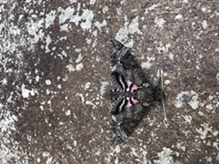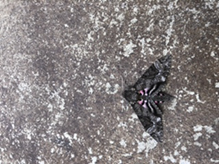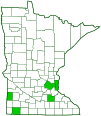pink-spotted hawkmoth
(Agrius cingulata)
Conservation • Description • Habitat • Ecology • Distribution • Taxonomy
|
||||||||
| Hodges # | 7771 |
|||||||
Conservation Status |
||||||||
| IUCN Red List | not listed |
|||||||
| NatureServe | N5 - Secure |
|||||||
| Minnesota | not listed |
|||||||
Description |
||
Pink-spotted hawkmoth is a very large sphinx moth. It is native to South and Central America. It migrates north each year to the eastern, central, and southwestern United States, rarely as far as southern Canada. It is a rare stray to southern Minnesota in late autumn. Larvae feed both day and night on the underside of leaves of plants in the Potato (Solanaceae) and Morning Glory (Convolvulaceae) families. Adults are found in a wide range of habitats but especially disturbed areas and agricultural areas. They are active at night and will come to lights. They feed on the nectar of many deep-throated flowers, including petunia, morning glory, and sweet potato. Adults are 2¼″ to 2⅝″ (55 to 65 mm) in length and have a 3¾″ to 4¾″ (95 to 120 mm) wingspan. The forewing length is 1 9⁄16″ to 2 5⁄16″ (40 to 58 mm). The body is robust. The eyes are very large. The antennae are mostly white with a brown stripe on the upper side. The abdomen tapers in the rear to a point. There is a broad, brown, longitudinal stripe in the middle (middorsal). The front half of each abdominal segment is bright pink, the rear half is black. This is the feature that gives the moth its common name and distinguishes it from all other moths in our area. The forewing is long, narrow, and pointed. The upper side is strongly mottled brown, grayish-brown, or brownish-gray. The median area is dark and has a small kidney-shaped spot (reniform spot) and two long black dashes behind the spot. The reniform spot is gray or white, and outlined with black. There are more black dashes in the subterminal area. The antemedial (AM) and postmedial (PM) lines are each represented by two jagged black lines. The subterminal (ST) line is black and often incomplete. The hind wing is bright pink at the base, gray in the postmedial area, and brown in the subterminal and terminal areas. It is crossed with three thick black lines, the innermost curved and almost heart-shaped, the outer two wavy. |
||
Size |
||
Total length: 2¼″ to 2⅝″ (55 to 65 mm) Wingspan: 3¾″ to 4¾″ (95 to 120 mm) |
||
Similar Species |
||
This is the only species in Minnesota that has pink spots on the abdomen. There are no similar species. |
||
Habitat |
||
A wide range of habitats, especially disturbed areas and agricultural areas |
||
Ecology |
||
Season |
||
One generation per year: Late fall in Minnesota In other areas, two or three generations per year. |
||
Behavior |
||
Adults are active at night |
||
Life Cycle |
||
The female lays a single egg on the underside of a leaf of a host plant. The larva feeds day and night. When mature it drops to the ground, burrows below the surface, creates a chamber, and pupates. |
||
Larva Hosts |
||
Plants in the Potato (Solanaceae) and Morning Glory (Convolvulaceae) families |
||
Adult Food |
||
Nectar from deep-throated flowers, including morning glory, sweet potato, and petunia |
||
Distribution |
||||
|
Sources |
|||
| 10/10/2022 | ||||
Occurrence |
||||
Rare stray in Minnesota |
||||
Taxonomy |
|||
Order |
Lepidoptera (Butterflies and Moths) | ||
Superfamily |
Bombycoidea (Hawk, Sphinx, Silk, Emperor, and Allied Moths) | ||
Family |
Sphingidae (sphinx moths) | ||
Subfamily |
Sphinginae (large sphinx moths) | ||
Tribe |
Sphingini | ||
| Subtribe | Acherontiina | ||
Genus |
Agrius | ||
Synonyms |
|||
Agrius cingulatus |
|||
Common Names |
|||
pink-spotted hawk moth pink-spotted hawkmoth |
|||
Glossary
Antemedial (AM) line
A thin line separating the basal area and the median area of the forewing of Lepidoptera.
Postmedial (PM) line
A thin line separating the median area and the postmedial area of the forewing of Lepidoptera.
Reniform spot
A kidney-shaped spot or outline in the lower median area near the PM line on the forewing of many moths.
Visitor Photos |
|||||
Share your photo of this insect. |
|||||
| This button not working for you? Simply email us at info@MinnesotaSeasons.com. Attach one or more photos and, if you like, a caption. |
|||||
Willis |
|||||
 |
 |
||||
MinnesotaSeasons.com Photos |
|||||
|
|||||

Slideshows |
||

Visitor Videos |
|||
Share your video of this insect. |
|||
| This button not working for you? Simply email us at info@MinnesotaSeasons.com. Attach a video, a YouTube link, or a cloud storage link. |
|||
Other Videos |
|||
| Agrius cingulata Tadej Tekavec |
|||
About
Premiered Aug 14, 2020 Agrius cingulata nočni metulj v okvari. |
|||
| OPVDFN. Polilla esfinge de pintas rosadas (Agrius cingulata). Poza Rica al natural |
|||
About
Oct 1, 2022 |
|||
| Pink-spotted Hawkmoth (Agrius cingulata) Alevilla Bandirosada VideotecaFaunaPR |
|||
About
Dec 9, 2019 Este lepidóptero pertenece a la familia Sphingidae. Su cuerpo es robusto, mayormente grisáseo y con una envergadura de ~ 10 cm. Vive en áreas bajas en los subtrópicos desde EUA hasta Argentina y el Caribe, como también en Hawaii según una colaboración de Daniel Pupo. Estas alevillas son excelentes voladoras. Su nombre común alude a las bandas rosado brillante en el abdomen. Las larvas se alimentan de las batatas mientras que los adultos son nectarívoros. Filmado en Morovis. Google Translate: This Lepidoptera belongs to the Sphingidae family. Its body is robust, mostly greyish and with a wingspan of ~ 10 cm. It lives in low-lying areas in the subtropics from the USA to Argentina and the Caribbean, as well as in Hawaii according to a collaboration by Daniel Pupo. These finches are excellent fliers. Its common name refers to the bright pink bands on the abdomen. The larvae feed on sweet potatoes while the adults are nectarivores. Filmed in Morovis. |
|||

Created: 10/10/2022
Last Updated:


